What to do if carrots rot during storage and why this happens
Many people are faced with the fact that after harvesting they cannot store carrots in the cellar until spring. Compared to other vegetables, it is more prone to fungal diseases. This vegetable has a thin skin through which bacteria can easily penetrate. Root vegetables begin to spoil and have to be thrown away. Let's look at why carrots rot during storage and how to save them.
Causes of carrot rot
Often, after harvesting, vegetable growers notice that the carrots lying in the cellar begin to rot. This happens for the following reasons:
- the summer was rainy, the crop was often watered, which is why water stagnated in the beds, the soil was waterlogged;
- the weather in summer was cold, the earth was not warmed up well;
- the soil is poor in potassium;
- It rained during harvest, so the carrots ended up in storage raw;
- root crops were collected after frost;
- the vegetables were not sorted before being placed in storage, so damaged or diseased specimens ended up in the cellar;
- the harvest was kept at high humidity and air temperature.
Even one of these reasons leads to the appearance of mold, and when several factors are combined, the risk of vegetable spoilage increases. Most often they are affected by brown and dry fusarium rot.
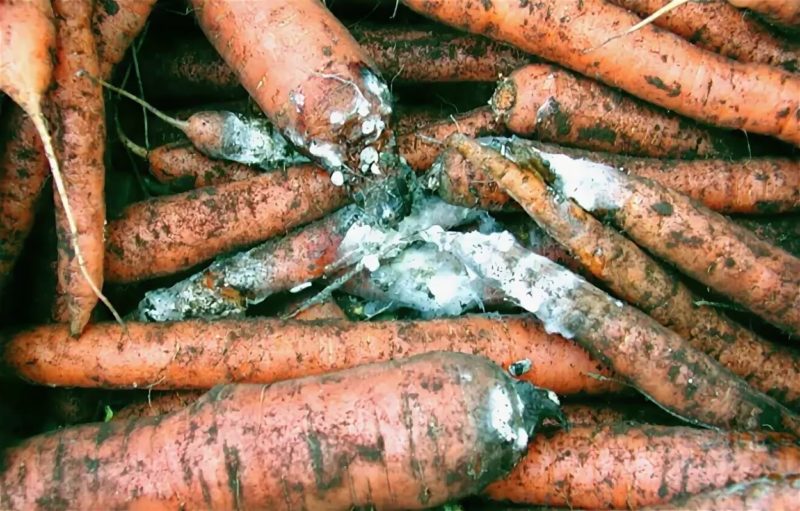
Diseases that cause rot
Rot does not appear immediately: the incubation period of diseases lasts from 3 weeks to 2 months. If you do not notice the danger in time, it is easy to lose the entire harvest.
White rot
When root crops grow, sclerotinia does not manifest itself, but by the time they ripen it becomes active.
Main features illnesses:
- The surface of the carrot becomes wet and slippery, but the color does not change.
- The affected areas become covered with a fungus that resembles white cotton wool. After some time, it thickens and hard black growths appear on the vegetables.
Sources of infection are soil and premises in which diseased vegetables were previously stored.
Important! Sclerotinia (the causative fungus) exhibits maximum activity at 4–9 weeks, so during this period the vegetables in the cellar are inspected again.
Infected carrots should not be eaten. It should not be thrown into the compost heap, as this will spread fungal spores throughout the area.
Gray rot
Gray mold, or botrythiosis, occurs due to hypothermia, insufficient watering and other violations of agricultural practices.
Main signs of the disease:
- carrots become soft and wet;
- covered with gray spots, in place of which thread-like stripes later form.
If measures are not taken, when storing contaminated vegetables in an isolated room, crop losses will amount to up to 85%.
Black rot
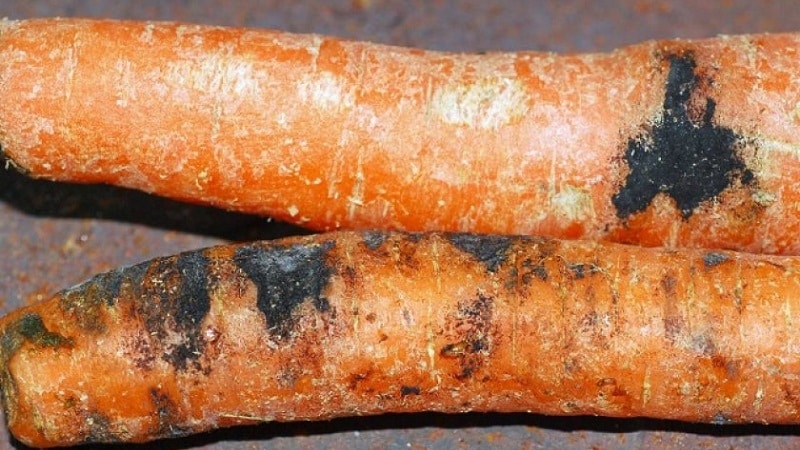
Alternaria blight is caused by carrot fly and mechanical damage to root crops. On the site, the sources of the disease are contaminated seeds and soil, fungal spores on garden tools.
Black rot is indicated by dark, sunken spots on root crops. These places over time turn black or acquire a dark olive color.
In a cold room the disease does not spread, but in humid and hot storage areas the fungus actively multiplies.
Scab
Crop losses from this disease reach 10%.Scab manifests itself 2-3 months after the carrots are placed in the cellar.
The fungus lives in the soil, so violation of crop rotation becomes the main cause of infection.
First, ulcers appear on the vegetables, then white mushroom mycelium appears. Over time, it changes color, becoming light brown.
Fomoz
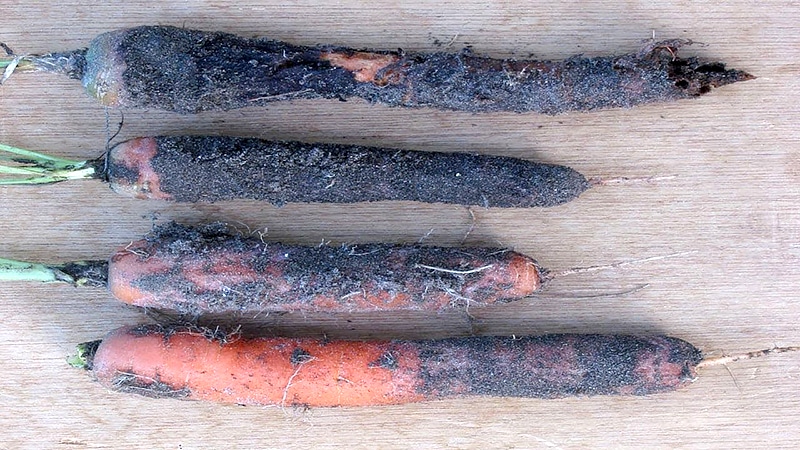
Brown rot is caused by contaminated seeds and soil. Fomoz leads to dark spots appearing on root crops and a sticky mass begins to stand out.
Reference. The fungus lives in the soil for up to 3 years and is not afraid of even severe frosts.
Fusarium rot
Soil is the main source of infection. Under favorable conditions, a fungus develops in it, which penetrates the plant and affects its vascular system and tissues.
First, dry ulcers form on the root crops and crack. Because of this, vegetables wrinkle, become covered with folds, and resemble “mummies.”
Other
Carrots growing in beds are affected by powdery mildew. It is identified by a gray coating on the tops and dark brown dots. The growth of root crops stops and they become stringy.
The disease occurs in hot weather, with alternating periods of drought and light rain.
During storage The harvest often develops rhizoctonia (felt disease). Vegetables first turn brown, and then soften and rot. The manifestation of rhizoctoniosis is observed even during the growth phase of carrots: gray spots appear on the root crops, which over time become covered with a purple coating with black sclerotia of the fungus.
The disease occurs on acidic soils with a lack of moisture and aeration.
What to do with rotting carrots
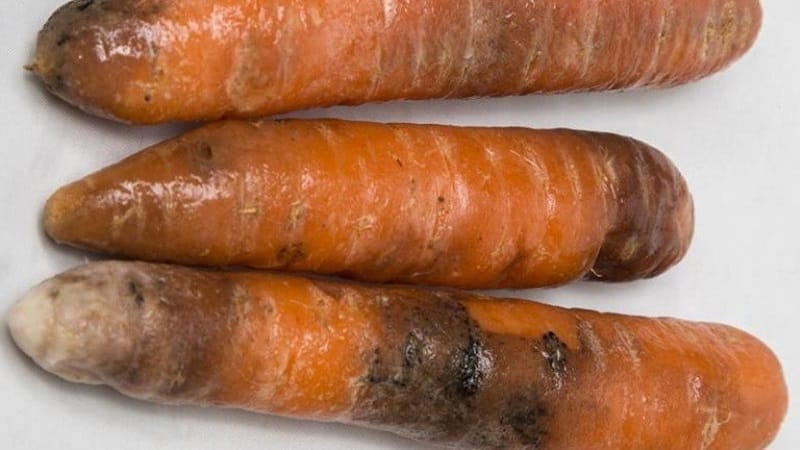
If the vegetables in storage begin to rot, they are sorted out. Damaged specimens are placed in plastic bags, removed or burned to destroy fungal spores. The container in which the carrots were placed is washed with a solution of potassium permanganate.
For further storage, completely healthy root vegetables are left. To protect against diseases, they are treated with Fitop-Flora-S.
Prevention measures
To prevent the harvest from going to waste, special attention is paid to disease prevention:
- To prevent white rot of carrots, crop rotation is observed: the crop is not planted after tomatoes or cucumbers. Increase the amount of potassium and phosphorus fertilizers.
- Separate storage of carrots and cabbage or celery will protect vegetables from gray rot. Before planting, the seeds are disinfected by keeping them in water heated to +50°C for half an hour.
- To ensure that the crop is not affected by Alternaria, the temperature regime is observed. Optimal values in the cellar are -2...+2°С, humidity is at least 80%. The room must be well ventilated.
- To protect against scab, the soil is limed. When storing vegetables, sprinkle them with dry sand or place them in plastic bags with holes.
- To prevent Phoma from developing, root crops are carefully dug out of the ground. When preparing the soil in autumn, add 40 g of potassium chloride per 1 m². 2 weeks before harvesting, the crop is fed with the same product (50 g per 10 liters of water).
- Compliance with the rules of crop rotation will protect root crops from fusarium. Seeds and soil are treated with Fundazol.
- To prevent powdery mildew, seeds are heated in hot (+50...+55°C) water, disinfected with a 1% solution of potassium permanganate, the rules of crop rotation are observed, and the plants are thinned out.
- To prevent rhizoctonia on carrots, soil liming is highly effective. The crop is not planted in one place more than once every 3-4 years. Plants are treated with HOM.
Before planting, not only humus, but also potassium fertilizers are added to the soil. Vegetables are dug up before frost sets in.
The brick walls of the cellar are scorched with a blowtorch or whitened with lime, and wooden surfaces are treated with lime milk.
This is interesting:
What to do if onions rot during storage and in the garden.
What to do if potatoes rot in the cellar.
Why pepper rots on the bush: identifying the cause of the problem.
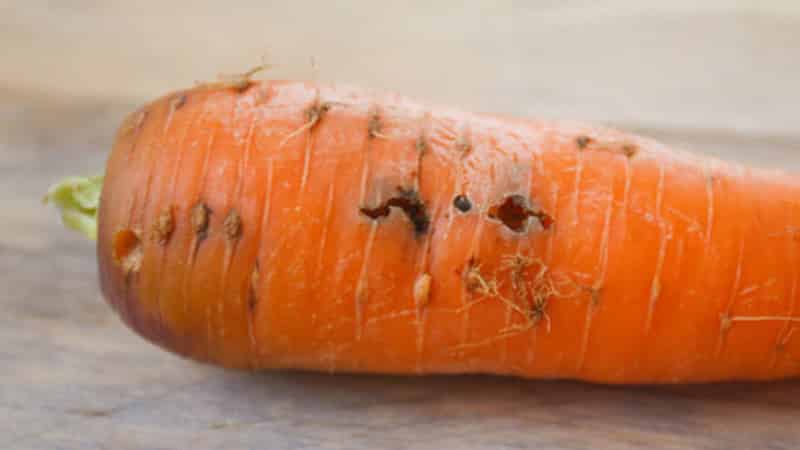
How to properly store carrots in a basement or subfield
Only healthy root crops without mechanical damage are sent to the cellar for storage. Carrots are kept in:
- sand;
- boxes;
- mele;
- clay;
- plastic bags.
Once every 2-3 weeks, vegetables are inspected and damaged roots are removed in a timely manner.
Advice. The harvest from the beds is harvested on a dry day at an air temperature of +4...+6°C. Carrot tops must be trimmed at a distance of 1 cm from the base of the root crop.
What to do if mold appears on carrots in the cellar? The harvest is removed, the storage facility is treated with antifungal agents or sulfur bombs, the walls are ventilated and insulated with waterproofing materials. The containers are washed with a solution of potassium permanganate, and the gardening gloves they were wearing are thrown away.
Conclusion
It is easier to prevent carrot rot than to fight it. To protect against fungus, the rules of crop rotation are observed and the crop is harvested before the first frost. The storage facility is whitewashed with lime every year, and containers for vegetables are disinfected. Only dry, healthy root vegetables are placed in the cellar. They are inspected regularly, rotten carrots are removed, burned or thrown away.
other sources do not recommend liming the soil; there is a risk of scab. who's lying?